key CHEVROLET EXPRESS 1998 1.G User Guide
[x] Cancel search | Manufacturer: CHEVROLET, Model Year: 1998, Model line: EXPRESS, Model: CHEVROLET EXPRESS 1998 1.GPages: 386, PDF Size: 20.74 MB
Page 80 of 386
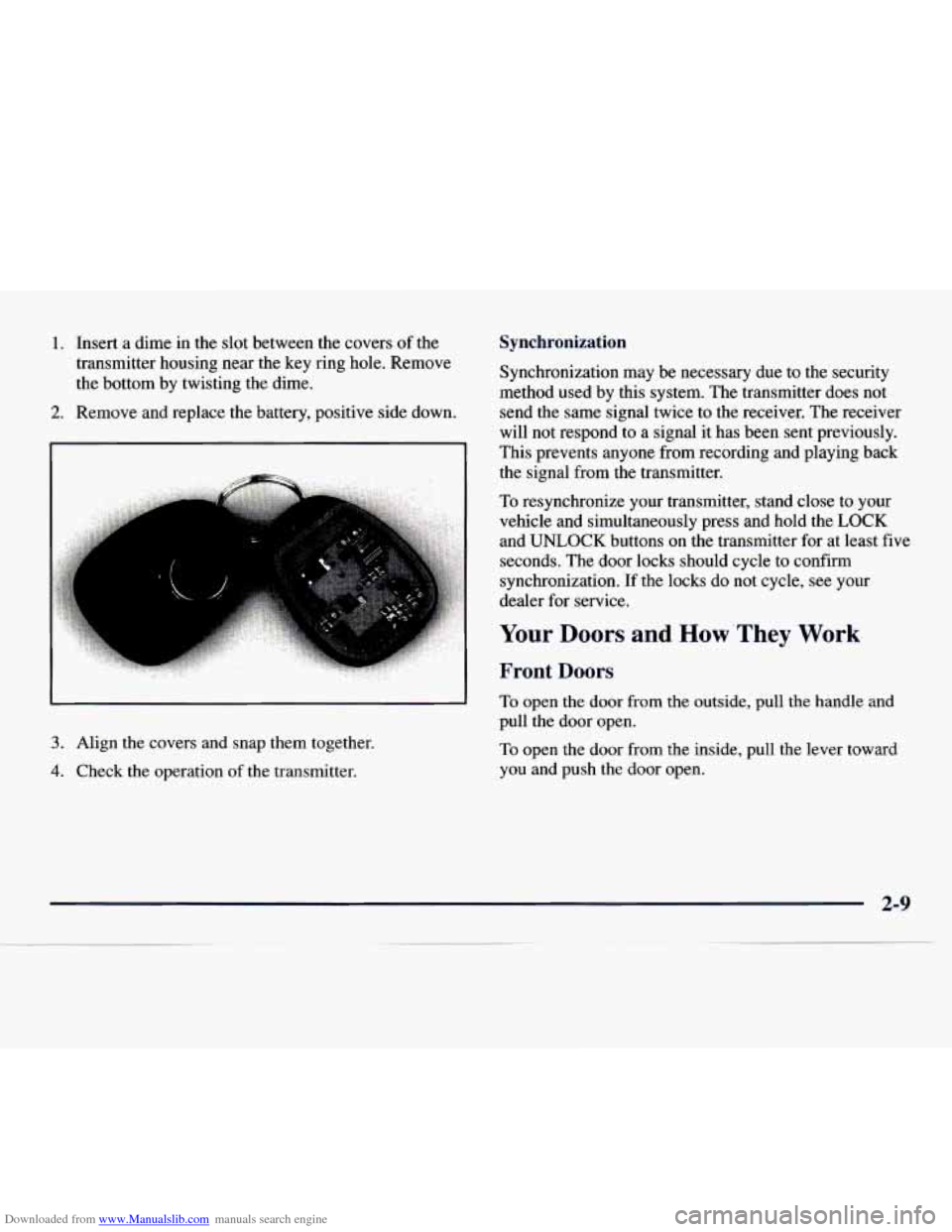
Downloaded from www.Manualslib.com manuals search engine 1. Insert a dime in the slot between the covers of the
transmitter housing near the
key ring hole. Remove
the bottom by twisting the dime.
2. Remove and replace the battery, positive side down.
3. Align the covers and snap them together.
4. Check the operation of the transmitter.
Synchronization
Synchronization may be necessary due to the security
method used by this system. The transmitter does not
send the same signal twice to the receiver. The receiver
will not respond to a signal it has been sent previously.
This prevents anyone from recording and playing back
the signal from the transmitter.
To resynchronize your transmitter, stand close
to your
vehicle and simultaneously press and hold the
LOCK
and UNLOCK buttons on the transmitter for at least five
seconds. The door locks should cycle to confirm
synchronization. If the locks do not cycle, see your
dealer for service.
Your Doors and How'They Work
Front Doors
To open the door from the outside, pull the handle and
pull the door open.
To open the door from the inside, pull the lever toward
you and push the door open.
Page 86 of 386
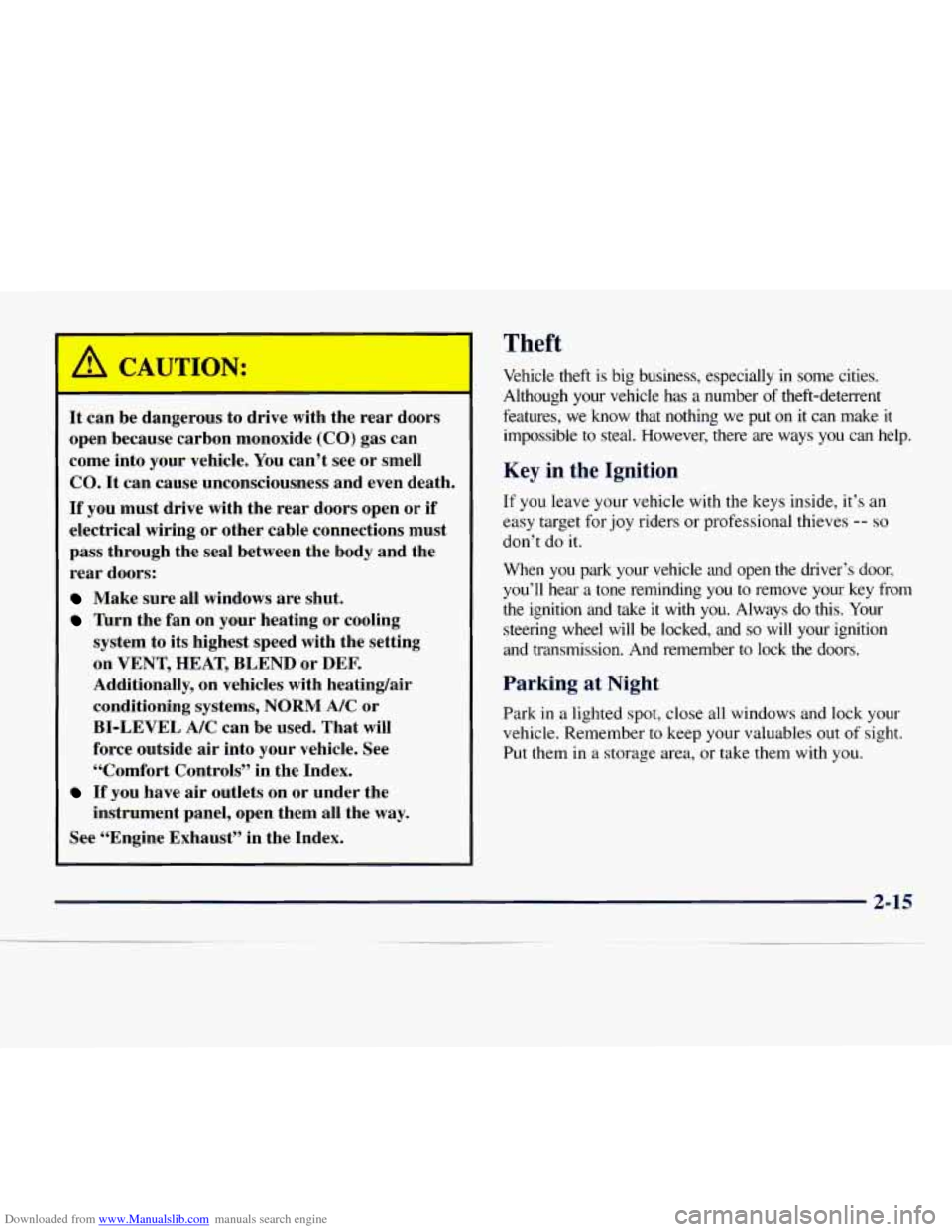
Downloaded from www.Manualslib.com manuals search engine A CA JTAN:
It can be dangerous to drive with the rear doors
open because carbon monoxide
(CO) gas can
come into your vehicle. You can’t see or smell
CO. It can cause unconsciousness and even death.
If you must drive with the rear doors open or if
electrical wiring or other cable connections must
pass through the seal between the body and the
rear doors:
Make sure all windows are shut.
I’urn the fan on your heating or cooling
system to its highest speed with the setting
on VENT, HEAT, BLEND or
DEF.
Additionally, on vehicles with heatindair
conditioning
systems, NORM A/C or
BI-LEVEL A/C can be used. That will
force outside air into your vehicle. See
“Comfort Controls” in the Index.
If you have air outlets on or under the
instrument panel, open them all the way.
See “Engine Exhaust” in the Index.
Theft
Vehicle theft is big business, especially in some cities.
Although your vehicle
has a number of theft-deterrent
features, we know
that nothing we put on it can make it
impossible to steal. However, there are ways
you can help.
Key in the Ignition
If you leave your vehicle with the keys inside, it’s an
easy target for joy riders or professional thieves
-- so
don’t do it.
When you park your vehicle
and open the driver’s door,
you’ll hear a tone reminding you
to remove your key from
the ignition and take it with
you. Always do this. Your
steering wheel will be locked, and
so will your ignition
and transmission. And remember
to lock the doors.
Parking at Night
Park in a lighted spot, close all windows and lock your
vehicle. Remember
to keep your valuables out of sight.
Put them in a storage area, or take them with you.
Page 87 of 386
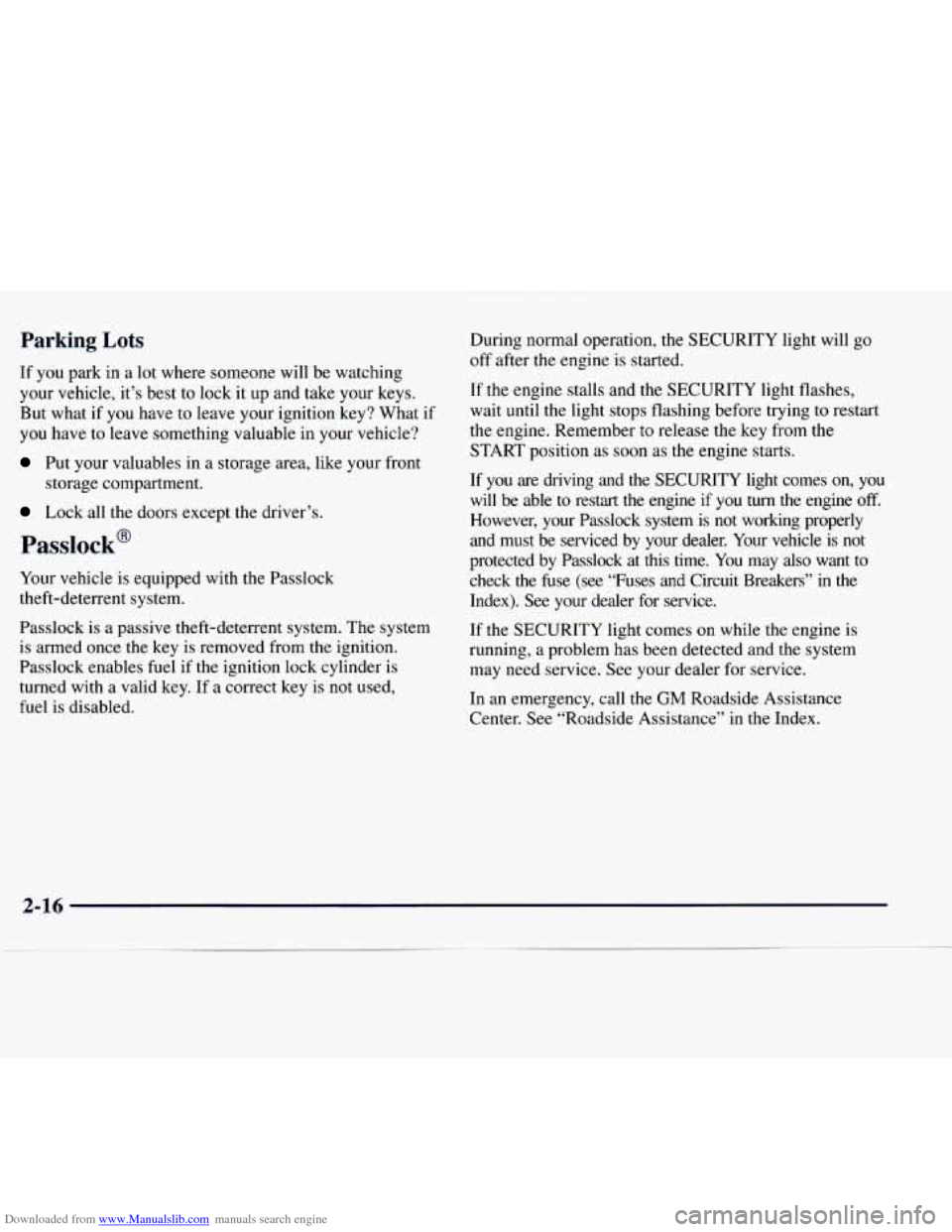
Downloaded from www.Manualslib.com manuals search engine Parking Lots
If you park in a lot where someone will be watching
your vehicle, it’s best
to lock it up and take your keys.
But what
if you have to leave your ignition key? What if
you have to leave something valuable in your vehicle?
Put your valuables in a storage area, like your front
Lock all the doors except the driver’s.
storage
compartment.
Passlock@
Your vehicle is equipped with the Passlock
theft-deterrent system.
Passlock
is a passive theft-deterrent system. The system
is armed once the key is removed from the ignition.
Passlock enables fuel if the ignition lock cylinder is
turned with
a valid key. If a correct key is not used,
fuel
is disabled. During normal
operation, the SECURITY light will
go
off after the engine is started.
If the engine stalls and the SECURITY light flashes,
wait
until the light stops flashing before trying to restart
the engine. Remember
to release the key from the
START position as soon as the engine starts.
If you are driving and the SECURITY light comes on, you
will be able to restart the engine if you turn the engine off.
However, your Passlock system is not working properly
and must be serviced by your dealer. Your vehicle is not
protected by Passlock at this time. You may
also want to
check the fuse (see “Fuses
and Circuit Breakers” in the
Index). See your dealer for service.
If the SECURITY light comes on while the engine is
running, a problem has been detected and the system
may need service. See your dealer for service.
In an emergency, call the
GM Roadside Assistance
Center. See “Roadside Assistance’’ in the Index.
2-16
Page 88 of 386
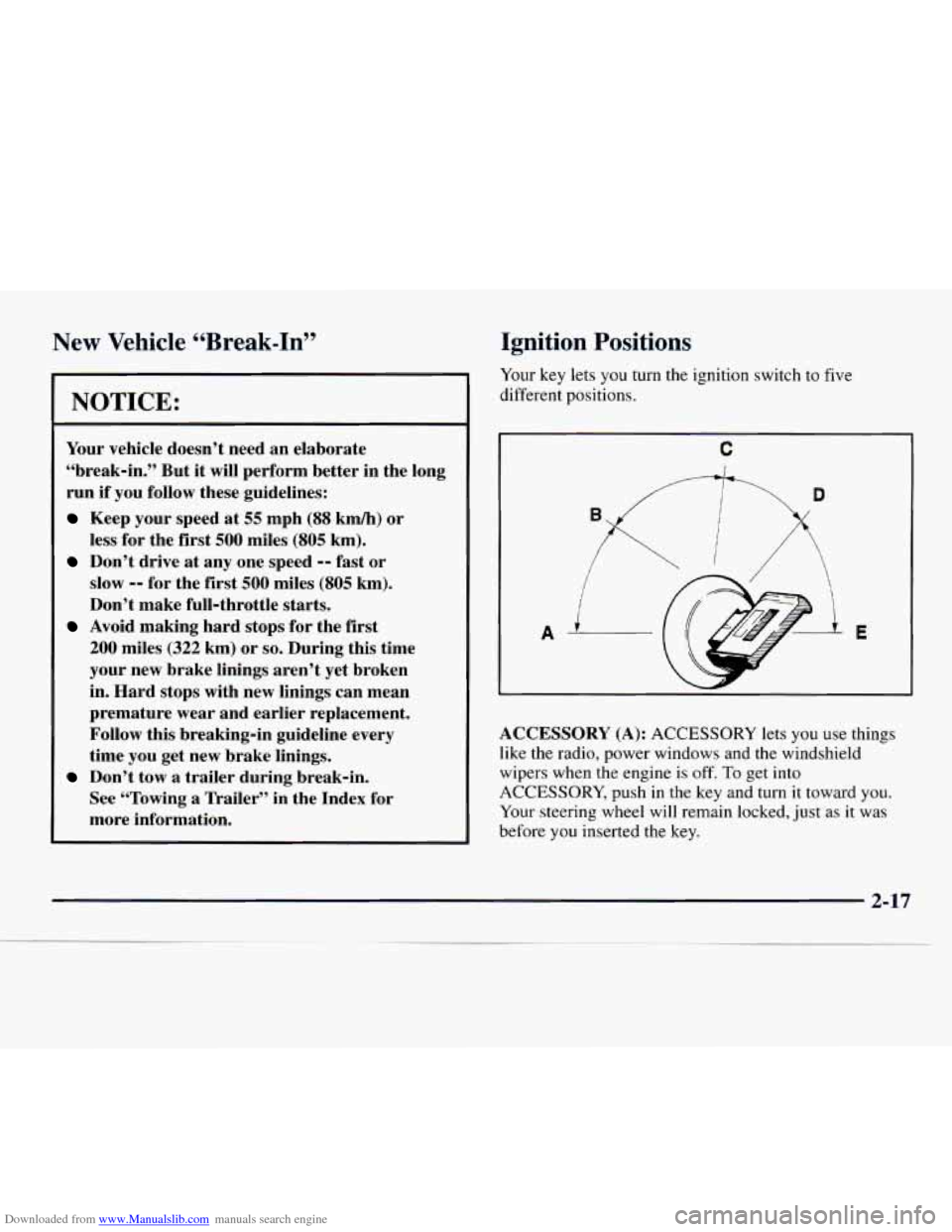
Downloaded from www.Manualslib.com manuals search engine New Vehicle 44Break-In”
NOTICE:
Your vehicle doesn’t need an elaborate
“break-in.” But it will perform better in the long
run
if you follow these guidelines:
Keep your speed at 55 mph (88 km/h) or
less for the first
500 miles (805 km).
Don’t drive at any one speed -- fast or
slow
-9 for the first 500 miles (805 km).
Don’t make full-throttle starts.
200 miles (322 km) or so. During this time
your new brake linings aren’t yet broken
in. Hard stops with new linings can mean
premature wear and earlier replacement.
Follow this breaking-in guideline every
time you get new brake linings.
See “Towing
a Trailer” in the Index for
more information.
Avoid making hard stops for the first
Don’t tow a trailer during break-in.
Ignition Positions
Your key lets you turn the ignition switch to five
different positions.
,------1---\D
C
A E
ACCESSORY (A): ACCESSORY lets you use things
like the radio, power windows and the windshield
wipers when the engine
is off. To get into
ACCESSORY, push in the key and turn it toward you.
Your steering wheel will remain locked, just
as it was
before you inserted
the key.
2-17
Page 89 of 386
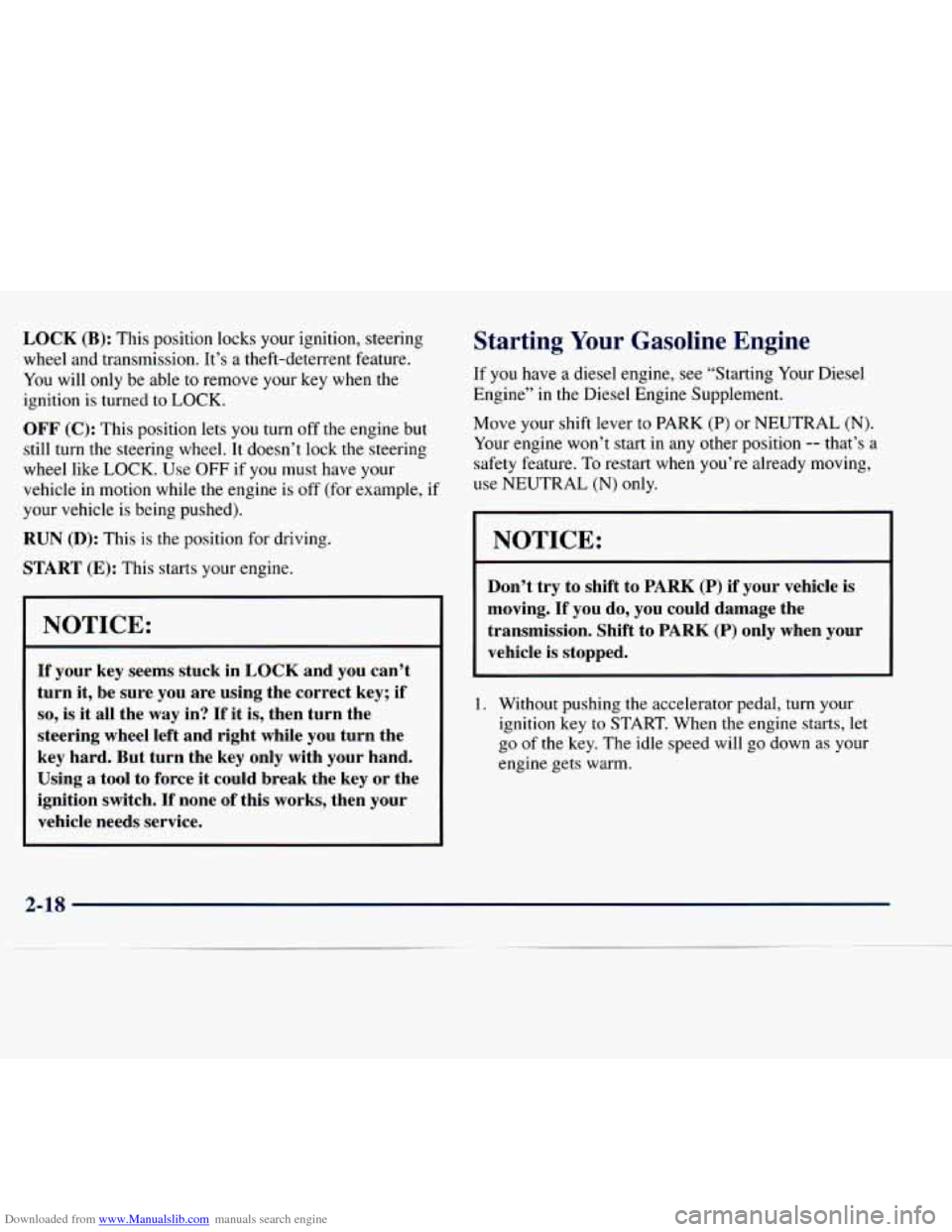
Downloaded from www.Manualslib.com manuals search engine LOCK (B): This position locks your ignition, steering
wheel and transmission.
It’s a theft-deterrent feature.
You will only be able to remove your key when the
ignition is turned
to LOCK.
OFF (C): This position lets you turn off the engine but
still
turn the steering wheel. It doesn’t lock the steering
wheel like LOCK. Use
OFF if you must have your
vehicle in motion while the engine is off (for example, if
your vehicle is being pushed).
RUN (D): This is the position for driving.
START (E): This starts your engine.
NOTICE:
If your key seems stuck in LOCK and you can’t
turn
it, be sure you are using the correct key; if
so, is it all the way in? If it is, then turn the
steering wheel left and right while you turn the
key hard. But turn the key only with your hand.
Using
a tool to force it could break the key or the
ignition switch. If none of this works, then your
vehicle needs service.
Starting Your Gasoline Engine
If you have a diesel engine, see “Starting Your Diesel
Engine” in
the Diesel Engine Supplement.
Move your shift lever to
PARK (P) or NEUTRAL (N).
Your engine won’t start in any other position -- that’s a
safety feature. To restart when you’re already moving,
use NEUTRAL
(N) only.
NOTICE:
Don’t try to shift to PARK (P) if your vehicle is
moving. If you do, you could damage the
transmission. Shift to
PARK (P) only when your
vehicle is stopped.
1. Without pushing the accelerator pedal, turn your
ignition key to START. When the engine starts, let
go
of the key. The idle speed will go down as your
engine gets warm.
2-1s
Page 90 of 386
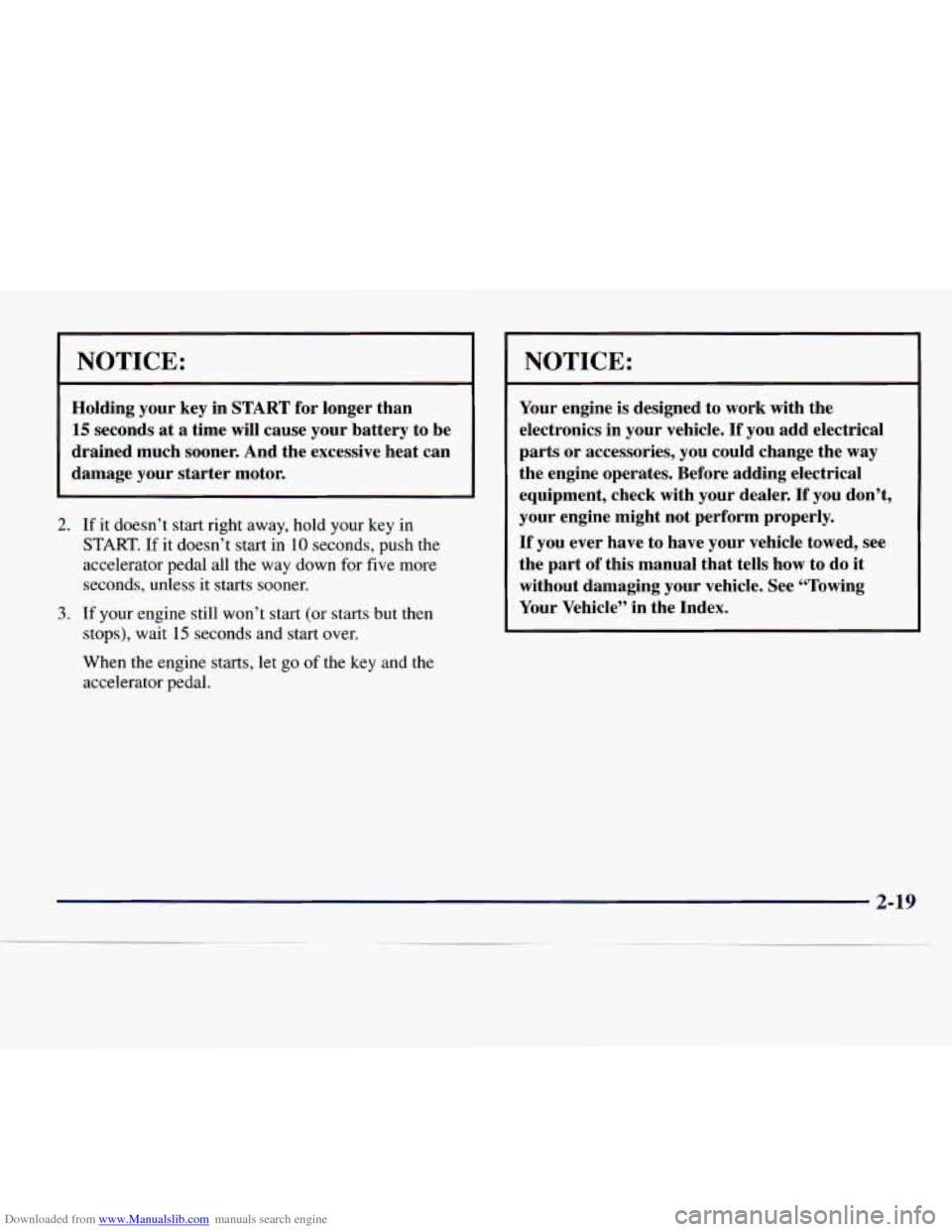
Downloaded from www.Manualslib.com manuals search engine NOTICE:
Holding your key in START for longer than
15 seconds at a time will cause your battery to be
drained much sooner. And the excessive heat can
damage your starter motor.
2.
3.
If it doesn’t start right away, hold your key in
START. If it doesn’t start in 10 seconds, push the
accelerator pedal all the way down
for five more
seconds, unless it starts sooner.
If your engine still won’t start (or starts but then
stops), wait
15 seconds and start over.
When the engine starts, let go
of the key and the
accelerator pedal.
NOTICE:
Your engine is designed to work with the
electronics in your vehicle.
If you add electrical
parts or accessories, you could change the way
the engine operates. Before adding electrical
equipment, check with your dealer. If
you don’t,
your engine might not perform properly.
If you ever have to have your vehicle towed, see
the part
of this manual that tells how to do it
without damaging your vehicle. See “Towing
Your Vehicle” in the Index.
Page 92 of 386
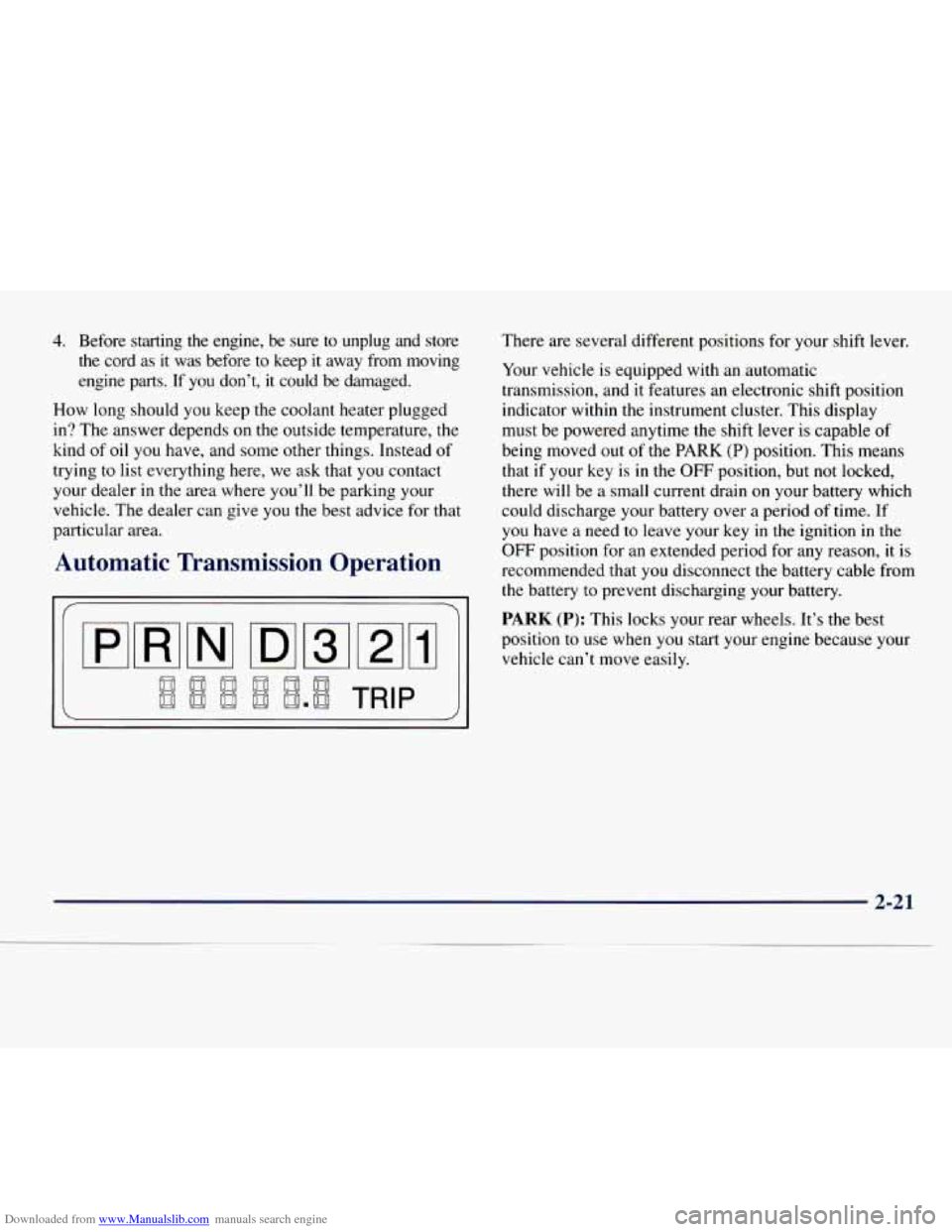
Downloaded from www.Manualslib.com manuals search engine 4. Before starting the engine, be sure to unplug and store
the cord as it was before
to keep it away from moving
engine parts. If you don’t, it could be damaged.
How long should you keep the coolant heater plugged
in? The answer depends on the outside temperature, the
kind of oil
you have, and some other things. Instead of
trying to list everything here, we ask that you contact
your dealer in the area where you’ll be parking your
vehicle. The dealer can give
you the best advice for that
particular area.
Automatic Transmission Operation
There are several different positions for your shift lever.
Your vehicle is equipped with an automatic
transmission, and it features an electronic shift position
indicator within the instrument cluster. This display
must be powered anytime the shift lever is capable of
being moved out of the
PARK (P) position. This means
that
if your key is in the OFF position, but not locked,
there will be a small current drain
on your battery which
could discharge your battery over a period
of time. If
you have a need to leave your key in the ignition in the
OFF position for an extended period for any reason, it is
recommended that
you disconnect the battery cable from
the battery
to prevent discharging your battery.
/DI 3 121 1 vehicle can’t move easily.
PARK (P): This locks your rear wheels. It’s the best
position to
use when you start your engine because your
2-21
Page 97 of 386
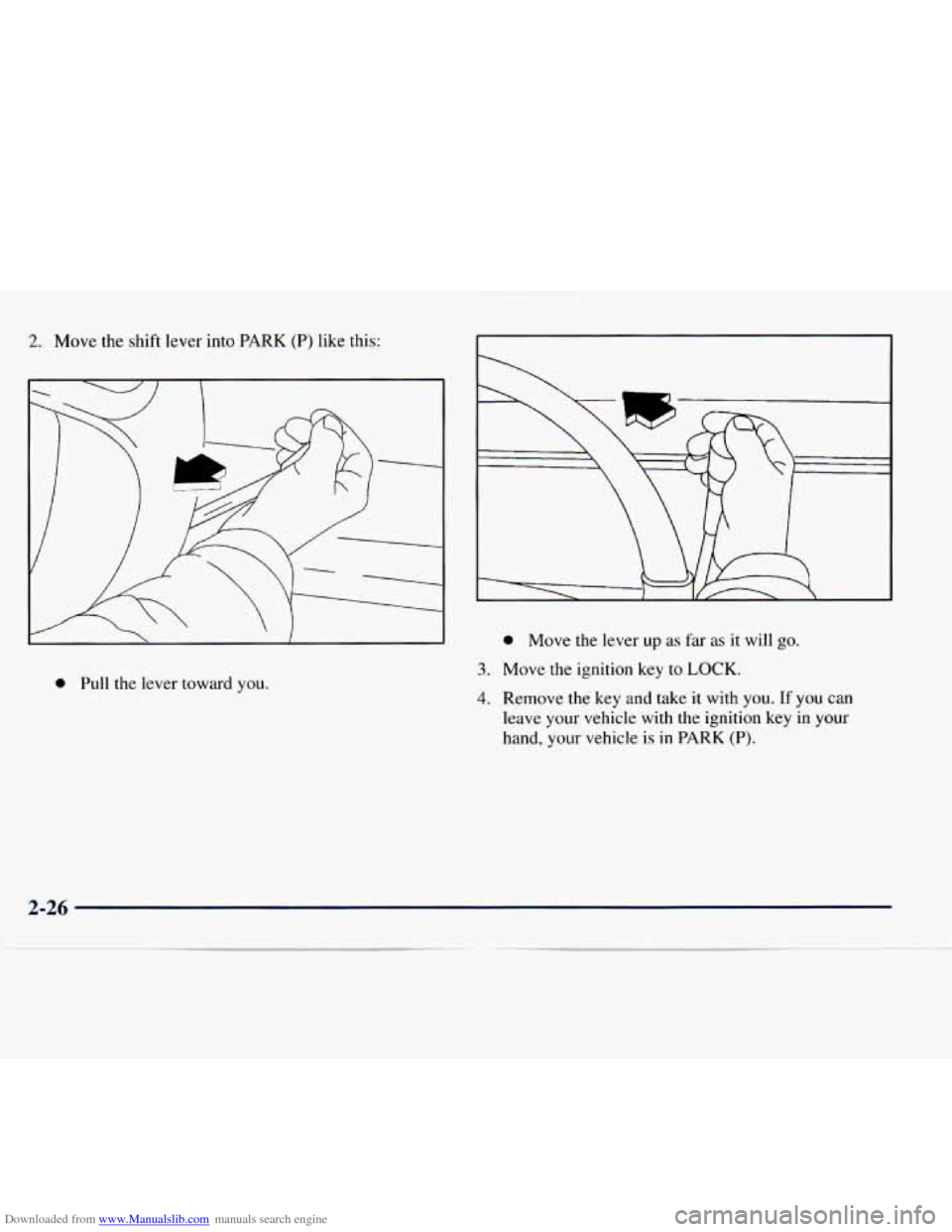
Downloaded from www.Manualslib.com manuals search engine 2. Move the shift lever into PARK (P) like this: r
0 Pull the lever toward you.
0 Move the lever up as far as it will go.
3. Move the ignition key to LOCK.
4. Remove the key and take it with you. If you can
leave
your vehicle with the ignition key in your
hand, your vehicle is
in PARK (P).
Page 99 of 386
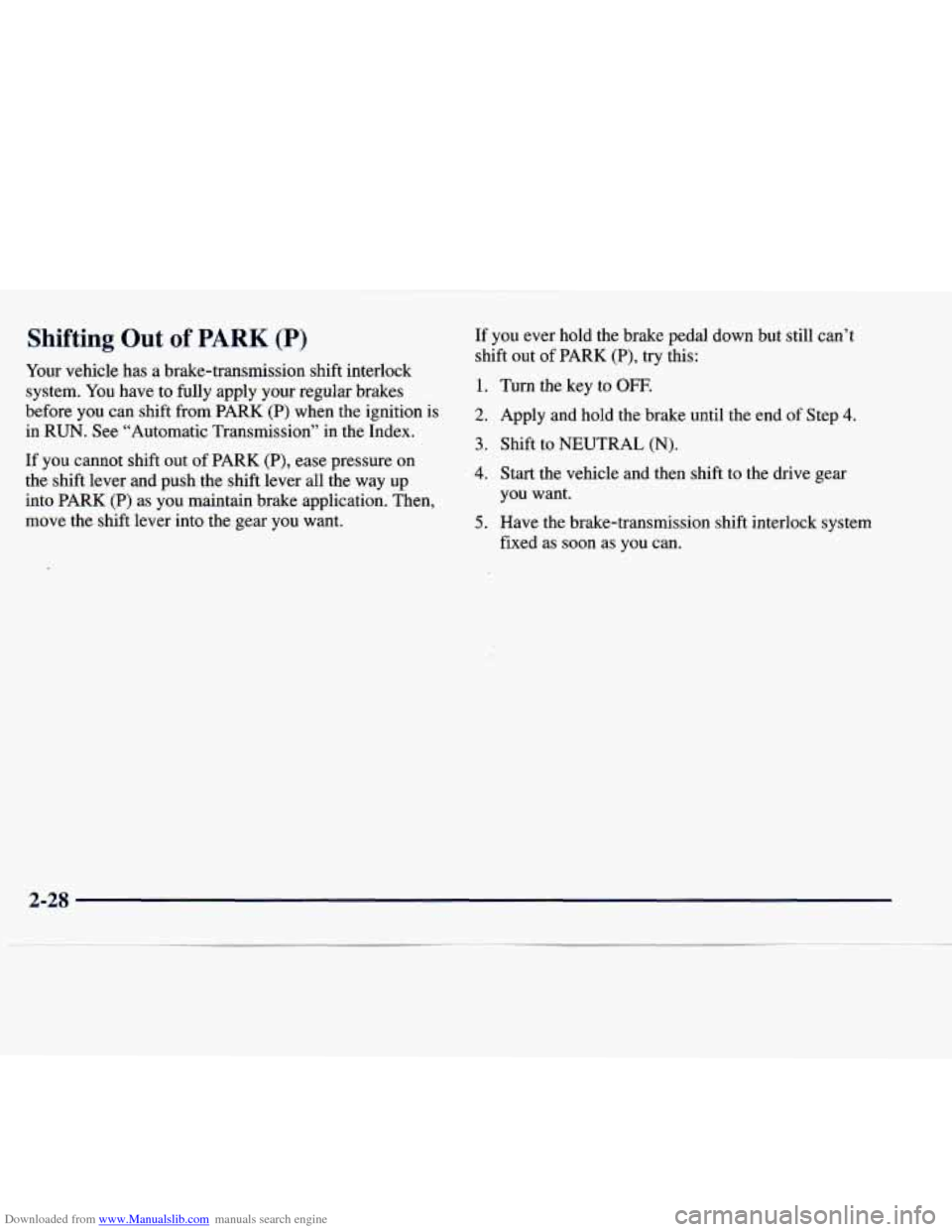
Downloaded from www.Manualslib.com manuals search engine Shifting Out of PARK (P) If you ever hold the brake pedal down but still can’t
shift out of PARK (P), try this:
Your vehicle has a brake-transmission shift interlock
system. You have to fully apply your regular brakes
1.
before you can shift from PARK (P) when the ignition is 2,
in RUN. See “Automatic Transmission” in the Index. 3.
If you cannot shift out of PARK (P), ease pressure on
the shift lever and push the shift lever all the way up 4.
into PARK (P) as you maintain brake application. Then,
move the shift lever into the gear you want.
5.
Turn the key to OFF.
Apply and hold the brake until the end of Step 4.
Shift to NEUTRAL (N).
Start the vehicle and then shift to the drive gear
you want.
Have the brake-transmission shift interlock system
fixed as soon as
you can.
2-28
Page 120 of 386
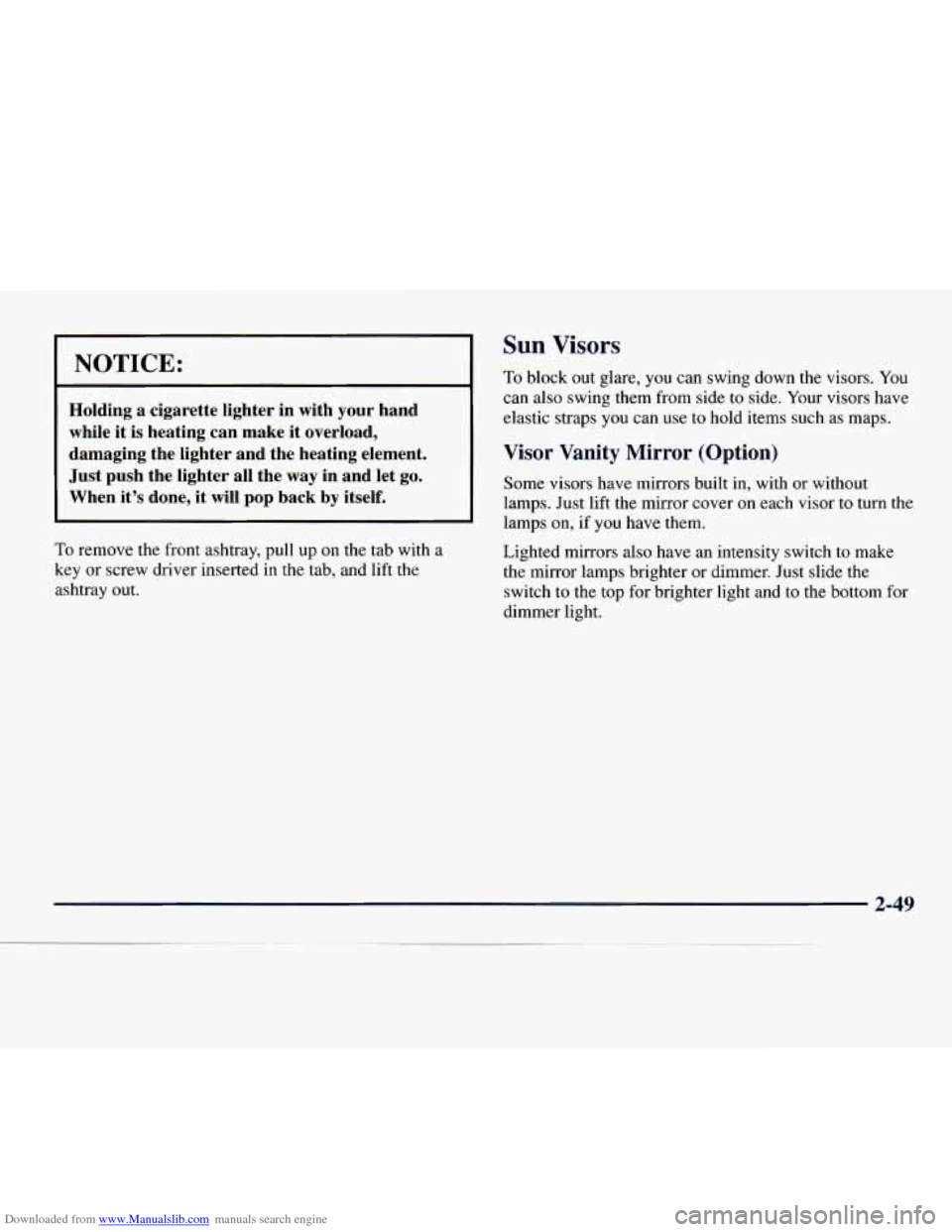
Downloaded from www.Manualslib.com manuals search engine NOTICE:
Holding a cigarette lighter in with your hand
while it is heating can make it overload.
Sun Visors
To block out glare, you can swing down the visors. You
can also swing them from side
to side. Your visors have
elastic straps you can use to hold items such as maps.
damaging the lighter and the heating element. Visor Vanity Mirror (Option)
Just push the lighter all the way in and let go.
When it’s done, it will pop back by itself. lamps. Just lift the mirror cover on each visor to turn the
Some
visors have mirrors built in, with or without
lamps on, if
you have them.
To remove the front ashtray, pull up on the tab with a
key or screw driver inserted in the tab, and lift the
ashtray out. Lighted
mirrors also have an intensity switch to make
the mirror lamps brighter or dimmer. Just slide the
switch
to the top for brighter light and to the bottom for
dimmer light.
2-49